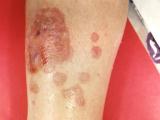Aug 11, 2011
Polio eradication efforts hit snag in Nigeria
Efforts toward polio eradication in Nigeria made great strides in 2010, only to slip a bit in early 2011, according to an update today in Morbidity and Mortality Weekly Report (MMWR). In 2009 the country confirmed 388 cases of wild poliovirus (WPV) infection, but in 2010 cases fell to 21. As of Jul 26, however, 2011 WPV cases totaled 24, including 1 case of a vaccine-derived co-infection. Vaccine-derived polio cases reached 154 in 2009, 27 in 2010, and 11 from January through June of this year. (For the same period in 2010, Nigeria confirmed 6 WPV cases and 10 vaccine-derived cases.) The authors note, "Despite substantial progress, immunization activities and surveillance sensitivity will need to be enhanced further to interrupt WPV transmission in Nigeria by the end of 2011."
Aug 12 MMWR report
New antiviral approach shows promise against multiple viruses
In preliminary studies in cell culture and mice, researchers from the Massachusetts Institute of Technology (MIT) Lincoln Laboratory showed that new broad-spectrum antivirals that they developed may be effective against multiple viruses, including influenza and rhinoviruses that cause the common cold. The approach works by targeting a type of RNA produced only in cells that have been infected by viruses, according to an MIT press release yesterday. "In theory, it should work against all viruses," said Todd Rider, a senior scientist at Lincoln Laboratory who invented the new technology. The broad-spectrum agents, called DRACOs (Double-stranded RNA Activated Caspase Oligomerizers) were effective in cell culture against rhinoviruses, dengue virus, and several other viruses that can cause hemorrhagic fever. In addition, they were shown effective against seasonal H1N1 influenza when injected into mice. The authors conclude in their study, "DRACOs have the potential to be effective therapeutics or prophylactics for numerous clinical and priority viruses."
Aug 10 MIT press release
Jul 27 PLoS One study
Wool workers stayed healthy despite exposure to anthrax agent
In a Belgian wool-processing plant in which Bacillus anthracis was found in raw goat hair and airborne dust, 12% of workers had antibodies to the bacterium, which causes anthrax, according to a study today in Epidemiology and Infection. Belgian researchers analyzed blood from 66 employees in the factory, where no anthrax cases have been reported. They found that 8 workers (12.1%) were seropositive, but 30% of those who process and 20% of those who sort raw goat hair were seropositive, compared with 3% for the rest of the plant workers. The researchers conclude, "Workers exposed to raw goat hair should be offered higher protection against anthrax and have access to anthrax vaccines."
H influenzae infections on the rise in Utah adults
The incidence of Haemophilus influenzae type b disease in Utah adults has grown more than 11-fold in 10 years and is especially high in the elderly, according to a study published yesterday in Emerging Infectious Diseases that also found an overall case-fatality rate of 22%. The researchers, from Utah and California, studied the incidence from 1998 through 2008 of H influenzae infection, which has long been combated with H influenzae type b (Hib) vaccine in children and can lead to meningitis, pneumonia, and other serious infections. They found that the incidence, as measured in 100,000 person-years, increased from 0.14 in 1998 to 1.61 in 2008. In people over 65, however, the 2008 incidence was 6.14. Overall incidence in that age-group was 2.74 and accounted for 51% of cases and 67% of deaths. The authors surmise, "The reasons for this change are unclear, and might reflect changes in the organisms, changes in the number of persons at high risk, or perhaps waning of cross-immunity induced by exposure to Hib."
Aug 10 Emerg Infect Dis study
US State Department issues warning about dengue in Bahamas
The US Embassy in Nassau warned Americans this week of a dengue fever outbreak in the Bahamas, with more than 200 confirmed and close to 1,000 suspected cases reported in the past few weeks. The country's health ministry has begun spraying communities, especially in densely populated areas, to control mosquitoes, said the Aug 9 warning from the US State Department. Bahamian officials are urging people to take steps to protect themselves from mosquito bites, the notice said. In an Aug 9 report in the Nassau Guardian newspaper, a Bahamian health official said the number of cases could be higher than reported because some people don't seek medical care. The story put the total of "clinically diagnosed and laboratory confirmed cases" at about 1,000. "Naturally the numbers will be a little bit higher because the illness is such that a lot of people can be cared for from home," Dr. Delon Brennen, deputy chief medical officer, told the newspaper.
Aug 9 US State Department statement
Aug 9 Guardian story
Study: Going organic lowered resistant bacteria on poultry farms
University of Maryland researchers who compared 10 conventional poultry farms with 10 newly converted organic farms found that the transition significantly dropped levels of antibiotic-resistant bacteria found on site, according to a study in Environmental Health Perspectives. "We initially hypothesized that we would see some differences in on-farm levels of antibiotic-resistant enterococci when poultry farms transitioned to organic practices. But we were surprised to see that the differences were so significant across several different classes of antibiotics even in the very first flock that was produced after the transition," said lead author Dr. Amy R. Sapkota in a press release. She and her colleagues tested for enterococci in poultry litter, feed, and water, and tested its resistance to 17 common antimicrobials. While all farms tested positive for enterococci, the newly organic farms had significantly lower levels of drug-resistant bacteria. For example, 67% of Enterococcus faecalis on conventional farms were resistant to erythromycin, while only 18% of those on organic farms were. In terms of bacteria resistant to three or more antibiotics, 42% of E faecalis samples on conventional farms were multi-drug resistant, compared with only 10% on newly organic farms, and for E faecium, the levels were 84% and 17%, respectively. "Now we need to look forward and see what happens over 5 years, 10 years in time," Sapkota said.
Aug 10 University of Maryland press release





















